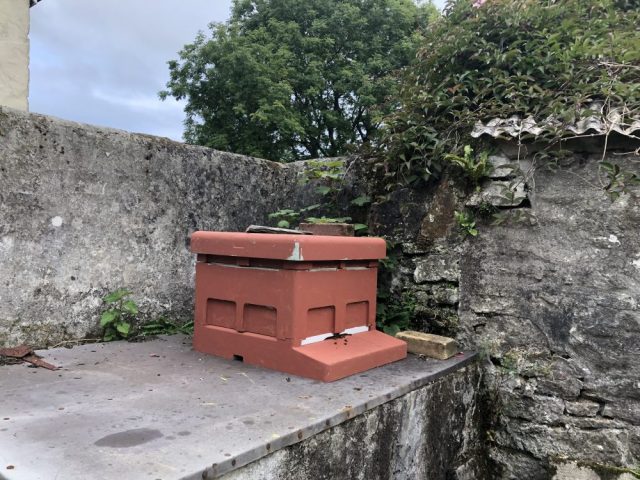My beekeeping activity is winding down now for the year. The threat of swarms has passed and my focus is now on getting them ready for winter. My Nessa hive seemed to lose Queen Nessa sometime in July, so I combined them with Queen Kensa’s hive using the traditional newspaper trick. Thankfully the resulting multi-storey hive didn’t break Drew’s home-made hive stand.
Meanwhile, my poly nuc colony (which I have named Demelza to continue my Cornish names theme), have been moved into a full-size poly hive. My reason for choosing a poly hive was a combination of economics and practicality: 1.) they’re a lot cheaper 2.) no hammering is required to put them together. They just need a coat of paint – I don’t know how I missed that corner! The downside is that you can’t sterilise them with a good blowtorching.
I’ve taken a small amount of honey from Kensa (3 frames), the rest is being left for the bees. As I don’t want to buy an extractor, and borrowing one through my local association feels like extra work, I’m going for a crush-and-strain method. I’m using muslin as a filter, supported by a colander steamer, so we’ll see how well that works.
The first step of my winter prep is treating against varroa mites, I like to do this in late August/early September. My usual autumn treatment is Apiguard, which is nice and easy. This year I’ve been trying out Api Life Var, as our local bee inspector recommends alternating thymol treatments each year. So far I’m not getting on that well with it, the wafers are so crumbly and have to be changed each week. I’ve also just read that Api Life Var shouldn’t be used with poly hives as it can melt them… oops.
Below is a little gallery of some of the flowers out in the late Cornish summer. Sedums, michaelmas daisies, sweetpeas and herbs like mint and oregano are in bloom. Just this week I’ve heard the modest pale-green flowers of ivy surrounded by buzzing. Blackberry is long over; it’s now time to pick the berries and apples in the garden. It’s officially apple crumble season – a very satisfying time of year. What’s flowering where you are?





No mention of the chimney colony . . . did that ever get resolved (did I miss a post) or are you living with them in there?
LikeLike
Having had a quote for nearly £7,000 to remove them humanely, I’m feeling reluctant to pay this. But I also feel bad organising their demise. So for now nothing has been done, they’re quite easy to ignore while we continue to go about our daily lives. My hope is they die out naturally from varroa, but they’ll probably turn out to be the most resilient bees ever.
LikeLike
Still, even if they die in there, won’t the honey and other stuff still block the chimney?
. . . but, if they turn out to be the most resilient bees ever, you could start a business selling resilient bees. Imagine your name going down into the annals of bee lore as having discovered a strain of bees that require little to no maintenance!
. . . of course, will all the chimneys in England plugged up by beehives, it could also be you’d be targeted with a massive class-action suit . . . better hope they die off, then.
LikeLike
Yeah, it will – but my hope is that we can then get a regular chimney sweep to push it out (strangely, the regular sweeps don’t like live bees!).
LikeLiked by 1 person
I don’t like that crumbly one either (varroa treatment). I alternate annually between a thymol treatment and amitraz, with oxalic vape in mid winter.
My bees are still on Himalayan balsam but they don’t appear to be bringing in much nectar.
LikeLike
Amitraz seems to take ages – ten weeks?! That doesn’t bother you though?
LikeLike
6 weeks isn’t it? Doesn’t bother me at all – just stick the strips in, very quick & nothing left to do apart from feed if needed. Randy Oliver puts the effective kill at 95% compared to 90% for 2x apiguard treatments. However I might keep in it reserve for really badly infested colonies in future.
LikeLike
Perhaps I’ll givr it a go next year then, thanks!
LikeLike
The ivy is just beginning to flower here in south Devon but insects know straight away.
LikeLike
I love seeing the ivy frenzies.
LikeLike
We have used the crush and strain method on naturally made comb in the spring, as we were going for honeycomb, and crushing the bits left over. Our spring honey has been exceptionally good and creamy and I am not sure if in part it is due to this crushing method. Good luck. Amelia
LikeLike
Interesting- thanks Amelia!
LikeLiked by 1 person
Amitraz sounds interesting to me as well. The Apiguard can be fiddly, and I often find some left over. Our swarm left out in the open has died off, more from weather. I think it has to be a massive, sustained infestation of varroa to kill a colony off really. Colonies tucked into chimneys, floorboards etc seem to be pretty resilient….
LikeLike
The colony in my chimney certainly seems to be doing well, sigh! Just wish they could do well somewhere that didn’t stop my fire working 😦
LikeLiked by 1 person
Seems like you are at a bit of an impasse. I had a friend, a beekeeper, who had them year after year underneath the floorboards, between the 1st and second floor of her house. Because she had small grandchildren, she felt there was only one choice…
LikeLike
What a funny place to have bees! I can understand why she felt that way.
LikeLiked by 1 person